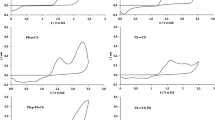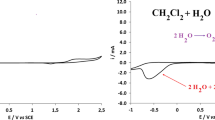Abstract
The bioinspiration is one of the best ways to make a breakthrough in a field, and particularly in the wetting properties. Bioinspired by natural species, such as rose petals and gecko foot, and previous researches, nanotubular structures are prepared here by soft-template electropolymerization in organic solvent and using an original benzotrithiophene with a hydrophilic carboxyl group, as the monomer. The best results are obtained by cyclic voltammetry because of a much higher amount of gas bubbles released with this deposition method. Both nanoparticles and nanotubes are observed while the water content has an influence on the number of nanotubes. Even if the monomer has hydrophilic carboxyl group, the best films have both high hydrophobicity (apparent water contact angle up to 130.7°) and strong water adhesion (petal effect). These surfaces could be used in future in applications such as water harvesting systems.







Similar content being viewed by others
Data Availability
The data that support the findings of this article are available in Journal of Bionic Engineering website (Springer) with the DOI of the article.
References
Peigney, A. (2003). Tougher ceramics with nanotubes. Nature Materials, 2, 15–16.
Montjoy, D. G., Hou, H., Bahng, J. H., & Kotov, N. A. (2020). Omnidispersible microscale colloids with nanoscale polymeric spikes. Chemistry of Materials, 32, 9897–9905.
Su, S., Wu, W. H., Gao, J. M., Lu, J. X., & Fan, C. H. (2012). Nanomaterials-based sensors for applications in environmental monitoring. Journal of Materials Chemistry, 22, 18101–18110.
Mitchell, M. J., Billingsley, M. M., Haley, R. M., Wechsler, M. E., Peppas, N. A., & Langer, R. (2021). Engineering precision nanoparticles for drug delivery. Nature Reviews Drug Discovery, 20, 101–124.
Pomerantseva, E., Bonaccorso, F., Feng, X. L., Cui, Y., & Gogotsi, Y. (2019). Energy storage: The future enabled by nanomaterials. Science, 366, 6468.
Ai, J. X., & Guo, Z. G. (2019). Biomimetic polymeric superamphiphobic surfaces: Their fabrication and applications. Chemical Communications, 55, 10820–10843.
Darmanin, T., & Guittard, F. (2015). Superhydrophobic and superoleophobic properties in nature. Materials Today, 18, 273–285.
Ensikat, H. J., Ditsche-Kuru, P., Neinhuis, C., & Barthlott, W. (2011). Superhydrophobicity in perfection: The outstanding properties of the lotus leaf. Beilstein Journal of Nanotechnology, 2, 152–161.
Cassie, A. B. D., & Baxter, S. (1944). Wettability of porous surfaces. Transactions of the Faraday Society, 40, 546–551.
Ge, L., Sethi, S., Ci, L., Ajayan, P. M., & Dhinojwala, A. (2007). Carbon nanotube-based synthetic gecko tapes. Proceedings of the National Academy of Sciences of the United States of America, 104, 10792–10795.
Feng, L., Zhang, Y., Xi, J. M., Zhu, Y., Wang, N., Xia, F., & Jiang, L. (2008). Petal effect: A superhydrophobic state with high adhesive force. Langmuir, 24, 4114–4119.
Bhushan, B., & Nosonovsky, M. (2010). The rose petal effect and the modes of superhydrophobicity. Philosophical Transactions of the Royal Society A, 368, 4713–4728.
Wenzel, R. N. (1936). Resistance of solid surfaces to wetting by water. Industrial and Engineering Chemistry, 28, 988–994.
Marmur, A. (2012). Hydro- hygro- oleo- omni-phobic? Terminology of wettability classification. Soft Matter, 8, 6867–6870.
Marmur, A. (2004). The lotus effect: Superhydrophobicity and metastability. Langmuir, 20, 3517–3519.
Cheng, Z. J., Gao, J., & Jiang, L. (2010). Tip geometry controls adhesive states of superhydrophobic surfaces. Langmuir, 26, 8233–8238.
Huang, J. Y., Zhang, K. Q., & Lai, Y. K. (2013). Fabrication, modification, and emerging applications of TiO2 nanotube arrays by electrochemical synthesis: A review. International Journal of Photoenergy. https://doi.org/10.1155/2013/761971
Lau, K. K. S., Bico, J., Teo, K. B. K., Chhowalla, M., Amaratunga, G. A. J., Milne, W. I., McKinley, G. H., & Gleason, K. K. (2003). Superhydrophobic carbon nanotube forests. Nano Letters, 3, 1701–1705.
Lai, Y. K., Pan, F., Xu, C., Fuchs, H., & Chi, L. F. (2013). In situ surface-modification-induced superhydrophobic patterns with reversible wettability and adhesion. Advanced Materials, 25, 1682–1686.
Lai, Y. K., Gao, X. F., Zhuang, H. F., Huang, J. Y., Lin, C. J., & Jiang, L. (2013). Designing superhydrophobic porous nanostructures with tunable water adhesion. Advanced Materials, 25, 1682–1686.
Zhang, S. N., Huang, J. Y., Tang, Y. X., Li, S. H., Ge, M. Z., Chen, Z., Zhang, K. Q., & Lai, Y. K. (2017). Understanding the role of dynamic wettability for condensate microdrop self-propelling based on designed superhydrophobic TiO2 nanostructures. Small (Weinheim an der Bergstrasse, Germany), 13, 1600687.
Lin, H. A., Luo, S. C., Zhu, B., Chen, C., Yamashita, Y., & Yu, H. H. (2013). Molecular or nanoscale structures? The deciding factor of surface properties on functionalized poly(3,4-ethylenedioxythiophene) nanorod arrays. Advanced Functional Materials, 23, 3212–3219.
Ai, S. F., Lu, G., He, Q., & Li, J. B. (2003). Highly flexible polyelectrolyte nanotubes. Journal of the American Chemical Society, 125, 11140–11141.
Kawamura, G., Muto, H., & Matsuda, A. (2014). Hard template synthesis of metal nanowires. Frontiers in Chemistry, 2, 104.
Fakhry, A., Cachet, H., & Debiemme-Chouvy, C. (2015). Mechanism of formation of templateless electrogenerated polypyrrole nanostructures. Electrochimica Acta, 179, 297–303.
Gupta, S. (2008). Hydrogen bubble-assisted syntheses of polypyrrole micro/nanostructures using electrochemistry: Structural and physical property characterization. Journal of Raman Spectroscopy, 39, 1343–1355.
Kim, J. T., Seol, S. K., Je, J. H., Hwu, Y., & Margaritondo, G. (2009). The microcontainer shape in electropolymerization on bubbles. Applied Physical Letters, 94, 034103.
Qu, L., Shi, G., Chen, F., & Zhang, J. (2003). Electrochemical growth of polypyrrole microcontainers. Macromolecules, 36, 1063–1067.
Parakhonskiy, B., Andreeva, D., Moehwald, H., & Shchukin, D. G. (2009). Hollow polypyrrole containers with regulated uptake/release properties. Langmuir, 25, 4780–4786.
Sane, O., Diouf, A., Morán Cruz, G., Savina, F., Méallet-Renault, R., Amigoni, S., Dieng, S. Y., Guittard, F., & Darmanin, T. (2019). Coral-like nanostructures. Materials Today, 31, 119–120.
Sathanikan, A., Ceccone, G., Bañuls-Ciscar, J., Pan, M., Kamal, F., Bsaibess, T., Gaucher, A., Prim, D., Méallet-Renault, R., Colpo, P., Amigoni, S., Guittard, F., & Darmanin, T. (2022). A bioinspired approach to fabricate fluorescent nanotubes with strong water adhesion by soft template electropolymerization and post-grafting. Journal of Colloid and Interface Science, 606, 236–247.
Fradin, C., Guittard, F., & Darmanin, T. (2021). A soft template approach to various porous nanostructures from conjugated carbazole-based monomers. Journal of Colloid and Interface Science, 584, 795–803.
Fradin, C., Orange, F., Amigoni, S., Szczepanski, C. R., Guittard, F., & Darmanin, T. (2021). Micellar formation by soft template electropolymerization in organic solvents. Journal of Colloid and Interface Science, 590, 260–267.
Levieux-Souid, Y., Sathanikan, A., Orange, F., Guittard, F., & Darmanin, T. (2021). Densely packed open microspheres by soft template electropolymerization of benzotrithiophene-based monomers. Electrochimica Acta, 369, 137677.
Sow, S., Dihissou, S., Dramé, A., Sene, A., Dieng, S. Y., Guittard, F., & Darmanin, T. (2022). Tunable nanotubular structures with rose petal effect by soft-template electropolymerization of benzotrithiophene monomers. ChemistrySelect, 7, e202200354.
Ringk, A., Lignie, A., Hou, Y., Alshareef, H. N., & Beaujuge, P. M. (2016). Electropolymerized star-shaped benzotrithiophenes yield π-conjugated hierarchical networks with high areal capacitance. ACS Applied Materials and Interfaces, 8, 12091–12100.
Patra, D., Chiang, C. C., Chen, W. A., Wei, K. H., Wu, M. C., & Chu, C. W. (2013). Solution-processed benzotrithiophene-based donor molecules for efficient bulk heterojunction solar cells. Journal of Materials Chemistry A, 1, 7767–7774.
Ramos Chagas, G., Xie, X., Darmanin, T., Steenkeste, K., Gaucher, A., Prim, D., Méallet-Renault, R., Godeau, G., Amigoni, S., & Guittard, F. (2016). Electrodeposition of polypyrenes with tunable hydrophobicity, water adhesion and fluorescence properties. Journal of Physical Chemistry C, 120, 7077–7087.
Raufaste, C., Ramos Chagas, G., Darmanin, T., Claudet, C., Guittard, F., & Celestini, F. (2017). Superpropulsion of droplets and soft elastic solids. Physical Review Letters, 119, 108001.
Young, T. (1805). An essay on the cohesion of fluids. Philosophical Transactions of the Royal Society of London, 95, 65–87.
Owens, D. K., & Wendt, R. C. (1969). Estimation of the surface free energy of polymers. Journal of Applied Polymer Science, 13, 1741–1747.
Darmanin, T., & Guittard, F. (2013). pH- and voltage-switchable superhydrophobic surfaces by electro-copolymerization of EDOT derivatives containing carboxylic acids and long alkyl chains. ChemPhysChem, 14, 2529–2533.
Ramos Chagas, G., Kiryanenko, D., Godeau, G., Guittard, F., & Darmanin, T. (2017). pH-driven wetting switchability of electrodeposited superhydrophobic copolymers of pyrene bearing acid functions and fluorinated chains. ChemPhysChem, 18, 3429–3436.
Luo, S. C., Sekine, J., Zhu, B., Zhao, H., Nakao, A., & Yu, H. H. (2012). Polydioxythiophene nanodots, nonowires, nano-networks, and tubular structures: The effect of functional groups and temperature in template-free electropolymerization. ACS Nano, 6, 3018–3026.
Zhao, Y., Stejskal, J., & Wang, J. (2013). Towards directional assembly of hierarchical structures: Aniline oligomers as the model precursors. Nanoscale, 5, 2620–2626.
Darmanin, T., & Guittard, F. (2017). The major influence of the substrate nature on the formation of nanotubes with high water adhesion using a templateless electropolymerization process. Synthetic Metals, 224, 99–108.
Darmanin, T., Bombera, R., Colpo, P., Valsesia, A., Laugier, J. P., Rossi, F., & Guittard, F. (2017). Bioinspired rose petal-like substrates generated by electropolymerization on micropatterned gold substrates. ChemPlusChem, 82, 352–357.
Darmanin, T., & Guittard, F. (2016). Templateless electrodeposition of conducting polymer nanotubes on mesh substrates for high water adhesion. Nano-Structures and Nano-Objects, 7, 64–68.
Fradin, C., Celestini, F., Guittard, F., & Darmanin, T. (2020). Templateless electrodeposition of conducting polymer nanotubes on mesh substrates. Macromolecular Chemistry and Physics, 221, 1900529.
Ramos Chagas, G., Fradin, C., Celestini, F., Guittard, F., & Darmanin, T. (2019). Dynamic wetting properties of mesh substrates with tunable water adhesion. ChemPhysChem, 20, 1905–1905.
Author information
Authors and Affiliations
Corresponding author
Ethics declarations
Conflict of Interest
The authors declare no conflict of interests/competing interests.
Additional information
Publisher's Note
Springer Nature remains neutral with regard to jurisdictional claims in published maps and institutional affiliations.
Rights and permissions
About this article
Cite this article
Khodja, M., Bousrih, I., El Kateb, M. et al. Formation of Nanotubular Structures with Petal Effect by Soft-Template Electropolymerization of Benzotrithiophene with Hydrophilic Carboxyl Group. J Bionic Eng 19, 1054–1063 (2022). https://doi.org/10.1007/s42235-022-00193-1
Received:
Revised:
Accepted:
Published:
Issue Date:
DOI: https://doi.org/10.1007/s42235-022-00193-1




